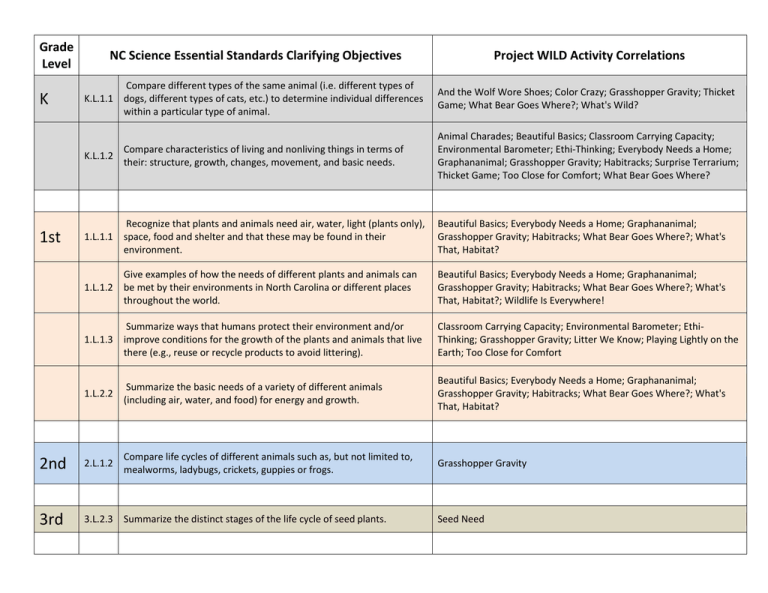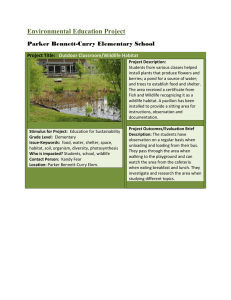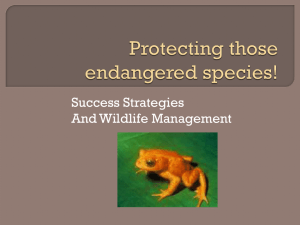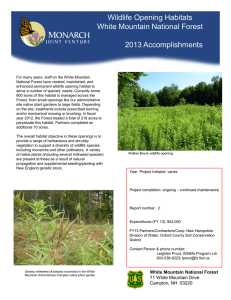Grade Level NC Science Essential Standards Clarifying Objectives
advertisement

Grade Level K 1st NC Science Essential Standards Clarifying Objectives Project WILD Activity Correlations Compare different types of the same animal (i.e. different types of K.L.1.1 dogs, different types of cats, etc.) to determine individual differences within a particular type of animal. And the Wolf Wore Shoes; Color Crazy; Grasshopper Gravity; Thicket Game; What Bear Goes Where?; What's Wild? Compare characteristics of living and nonliving things in terms of K.L.1.2 their: structure, growth, changes, movement, and basic needs. Animal Charades; Beautiful Basics; Classroom Carrying Capacity; Environmental Barometer; Ethi-Thinking; Everybody Needs a Home; Graphananimal; Grasshopper Gravity; Habitracks; Surprise Terrarium; Thicket Game; Too Close for Comfort; What Bear Goes Where? Recognize that plants and animals need air, water, light (plants only), 1.L.1.1 space, food and shelter and that these may be found in their environment. Beautiful Basics; Everybody Needs a Home; Graphananimal; Grasshopper Gravity; Habitracks; What Bear Goes Where?; What's That, Habitat? Give examples of how the needs of different plants and animals can 1.L.1.2 be met by their environments in North Carolina or different places throughout the world. Beautiful Basics; Everybody Needs a Home; Graphananimal; Grasshopper Gravity; Habitracks; What Bear Goes Where?; What's That, Habitat?; Wildlife Is Everywhere! Summarize ways that humans protect their environment and/or 1.L.1.3 improve conditions for the growth of the plants and animals that live there (e.g., reuse or recycle products to avoid littering). Classroom Carrying Capacity; Environmental Barometer; EthiThinking; Grasshopper Gravity; Litter We Know; Playing Lightly on the Earth; Too Close for Comfort 1.L.2.2 Summarize the basic needs of a variety of different animals (including air, water, and food) for energy and growth. Beautiful Basics; Everybody Needs a Home; Graphananimal; Grasshopper Gravity; Habitracks; What Bear Goes Where?; What's That, Habitat? 2nd 2.L.1.2 Compare life cycles of different animals such as, but not limited to, mealworms, ladybugs, crickets, guppies or frogs. Grasshopper Gravity 3rd 3.L.2.3 Summarize the distinct stages of the life cycle of seed plants. Seed Need 4th 4.L.1.1 4.L.1.2 Give examples of changes in an organism’s environment that are beneficial to it and some that are harmful. Changing Attitudes; Changing the Land; Checks and Balances; EnviroEthics; Environmental Barometer; Ethi-Thinking; Flip the Switch for Wildlife; Hazardous Links, Possible Solutions; How Many Bears Can Live in This Forest?; Improving Wildlife Habitat in the Community; Muskox Maneuvers; No Water Off a Duck's Back; Oh Deer!; Planning for People and Wildlife; Planting Animals; Prairie Memoirs; Rainfall and the Forest; Rare Bird Eggs for Sale; Riparian Zone; Shrinking Habitat; Smokey Bear Said What?; To Zone or Not to Zone Explain how animals meet their needs by using behaviors in response to information received from the environment. Checks and Balances; Hazardous Links, Possible Solutions; Here Today, Gone Tomorrow; How Many Bears Can Live in This Forest?; Improving Wildlife Habitat in the Community; Muskox Maneuvers; Oh Deer!; Quick Frozen Critters; Rainfall and the Forest; Shrinking Habitat; To Zone or Not to Zone Explain how humans can adapt their behavior to live in changing 4.L.1.3 habitats (e.g., recycling wastes, establishing rain gardens, planting trees and shrubs to prevent flooding and erosion). Changing the Land; Checks and Balances; Enviro-Ethics; EthiReasoning; Ethi-Thinking; Hazardous Links, Possible Solutions; Litter We Know; Microtrek Treasure Hunt; Migration Barriers; No Water Off a Duck's Back; Noisy Neighbors; Planning for People and Wildlife; Playing Lightly on the Earth; Pro and Con: Consumptive and Nonconsumptive Uses of Wildlife; Shrinking Habitat; To Zone or Not to Zone; Too Close for Comfort; What Did Your Lunch Cost Wildlife? Explain how differences among animals of the same population 4.L.1.4 sometimes give individuals an advantage in surviving and reproducing in changing habitats. Adaptation Artistry; Color Crazy; Seeing Is Believing!; Thicket Game; What Bears Goes Where? Classify substances as food or non-food items based on their ability to 4.L.2.1 provide energy and materials for survival, growth, and repair of the body. How Many Bears Can Live in This Forest? 5th Compare the characteristics of several common ecosystems, 5.L.2.1 including estuaries and salt marshes, oceans, lakes and ponds, forests, and grasslands. Adaptation Artistry; Ants on a Twig; Career Critters; Microtrek Treasure Hunt; Move Over Rover; Smokey Bear Said What?; Time Lapse; What Bear Goes Where?; Which Niche?; Who Fits Here?; Wildlife Is Everywhere! Classify the organisms within an ecosystem according to the function they serve: producers, consumers, or decomposers (biotic factors). Ants on a Twig; Energy Pipeline; Good Buddies; Muskox Maneuvers; Oh Deer!; Owl Pellets; Which Niche? 5.L.2.3 Infer the effects that may result from the interconnected relationship of plants and animals to their ecosystem. Adaptation Artistry; checks and Balances; Classroom Carrying Capacity; Eco-Enrichers; Energy Pipeline; Good Buddies; Habitat Rummy; Here Today, Gone Tomorrow; How Many Bears Can Live in This Forest?; Improving Wildlife Habitat in the Community; Microtrek Treasure Hunt; Move Over Rover; Muskox Maneuvers; Oh Deer!; Planting Animals; Prairie Memoirs; Quick Frozen Critters; Rainfall and the Forest; Riparian Zone; Seed Need; Shrinking Habitat; Time Lapse; What's For Dinner; Which Niche?; Who Fits Here?; Wildlife Is Everywhere 5.L.3.1 Explain why organisms differ from or are similar to their parents based on the characteristics of the organism. Adaptation Artistry 5.L.2.2 5.L.3.2 Give examples of likenesses that are inherited and some that are not. Adaptation Artistry





